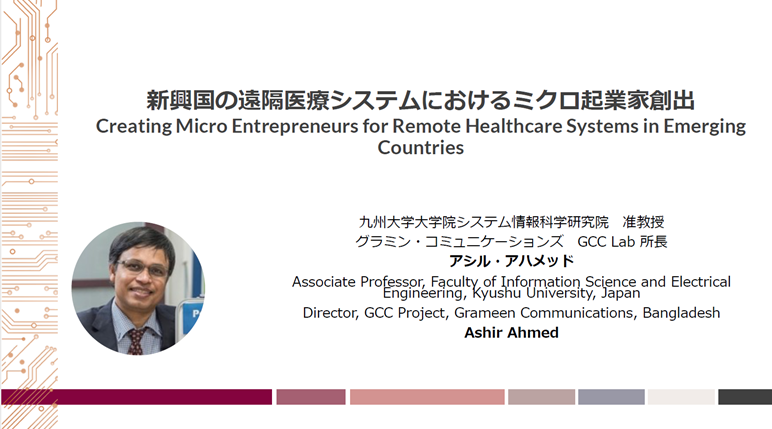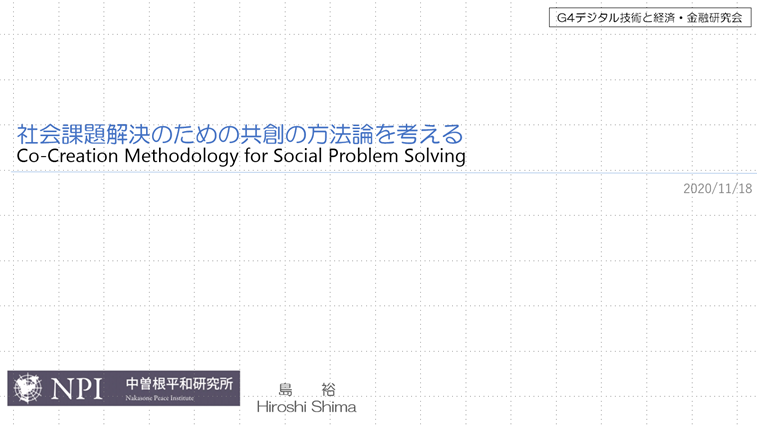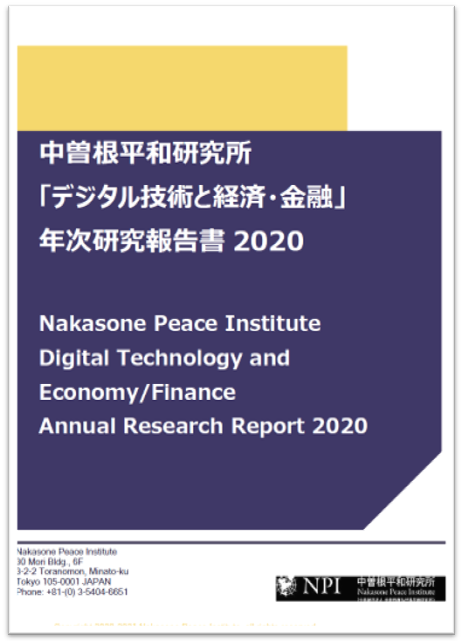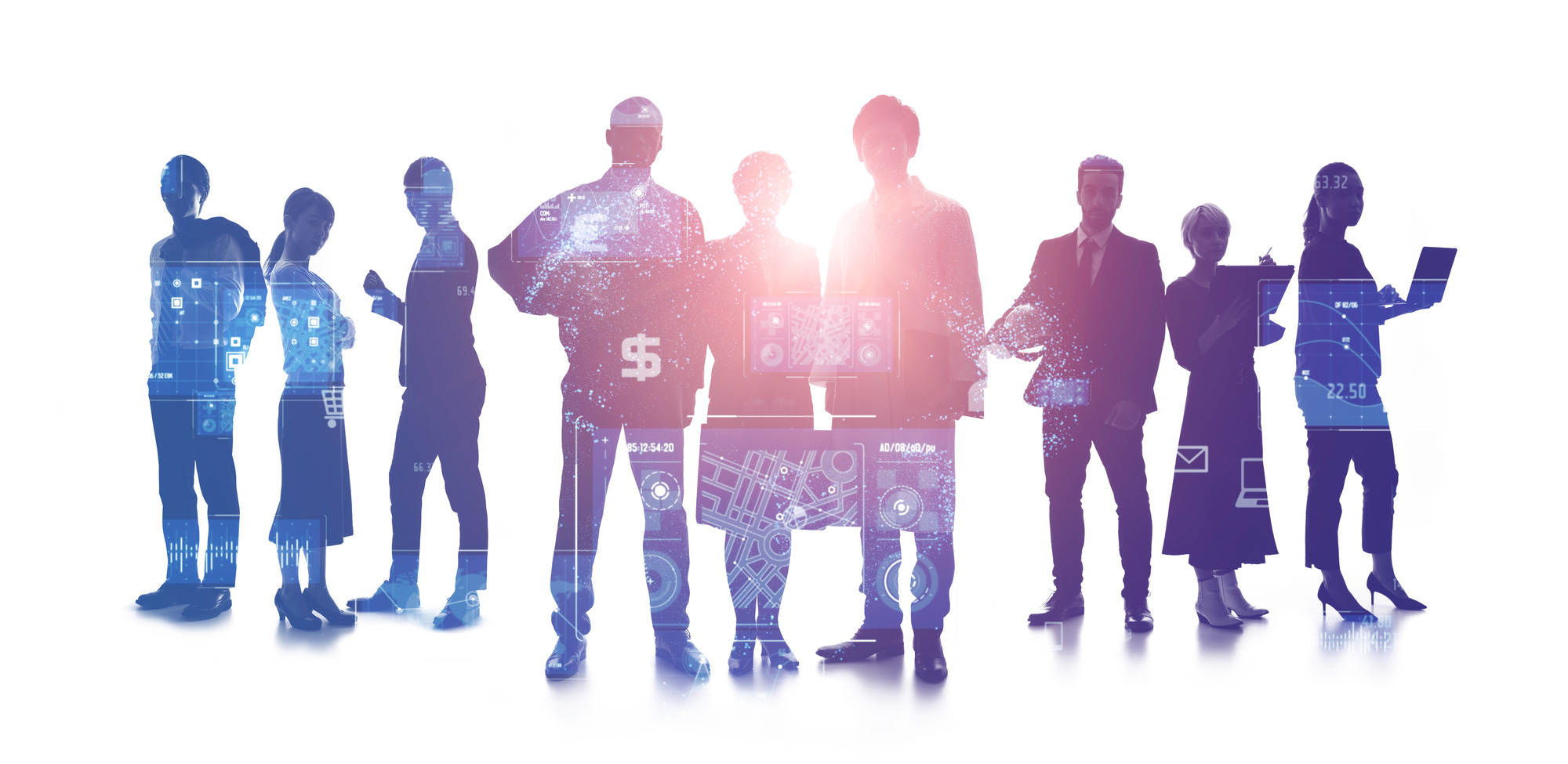2020/12/24
"Technology-based International Social Problem Solving in the Future" ("Digital Technology and Economy/Finance" Study Group)
The Nakasone Peace Institute (NPI) held the web conference on "Challenges in Technological Innovation with respect to International Cooperation and Collaboration" with Mr. Tatsuo Kawasaki (Ex. Senior Advisor, Telecommunication Advancement Foundation) , Dr. Ahmed Ashir (Associate Professor, Kyushu University), Mr. Hiroshi Shima (Senior Research Fellow, NPI), and other regular/visiting members, on November 18th 2020.
1 Presentation " ICT/Social Business to solve social problems and to achieve SDGs " (Mr. Kawasaki) & "Creating Micro Entrepreneurs for Remote Healthcare Systems in Emerging Countries" (Dr. Ashir)
■Increasing importance of confidential information management in universities and the need for a balanced approach (Mr. Kawasaki)
The practical case presented today is a remote health monitoring project in Bangladesh. I am assisting to shape the project into a social business company. I have two direct connections- (a) This project is partially supported by the Foundation for Telecommunications Advancement Foundation (TAF) to train the trainers of rural unemployment girls to become healthcare entrepreneurs. I served as a senior advisor to TAF. (b) I chaired a session in an international conference where 2006 Nobel Peace Prize winner Dr. Muhammad Yunus served as a key note speaker. We discussed how DX can assist solving social problems.
There are three points for you to discuss today:
1) How can digital technology-based social business be used to solve social issues such as poverty and access to health care, among others, in order to achieve the SDGs?
2) The impact of digital transformation (DX) on social issues and innovation in emerging countries, and its implications and applicability to Japan.
3) The potential of social business and the challenges to be overcome.
■ Bangladesh, a country where the spread of mobile applications is leading social change (Dr. Ashir)
My home country, Bangladesh, is the world's eighth largest cell phone-user nation, with 165 million lines, larger than Japan's and almost as many as the population of Bangladesh (that is, one phone per person). The growth of cell phone lines, Internet users, and social media users are all at about 10% per year, making it one of the world's leading countries in terms of digital growth.
Furthermore, the deployment and upgrade of high-speed broadband is driven by the mobile network, and with the help of a young population, the use of prepaid cell phones, and an emphasis on mobile payment methods, it is no doubt that mobile use is the basis of the country's vitality.
This situation is very different from that of developed countries, but it can be said that there is an opportunity to solve traditional social problems at once, led by the rapid diffusion of cell phones and applications.
■Bangladesh's low-income population to micro-entrepreneurs! (Dr. Ashir)
Like other developing countries, Bangladesh, with a population of just under 170 million, has a majority of low-income earners at the bottom of the pyramid (BOP), and in order to achieve the SDGs, it is important to transform these people into micro-entrepreneurs, for which the use of ICT by the youth is an indispensable tool.
Bangladesh has a history of transforming these BOP into micro-entrepreneurs at the community level through microfinance. A pioneering example is the Grameen Bank in the 1980s. It was followed by Grameenphone (cell phones as public telephones) in the 1990s and Grameen Shakti (community electricity supplied by household solar panels) in the 2000s.
■ A 10-year experiment in telemedicine utilizing a young rural workforce (Dr. Ashir)
The demonstration experiment, which began in 2010, specializes in "portable health clinics" in rural areas. Specifically, the patients are first examined by a "health care worker" stationed in each rural area who carries a "Portable Health Clinic Box (GENKI Box)" containing sensors, reagents, and a tablet PC, which was mainly made with Japanese technology. The health care workers then determine whether the patient's illness is one that can be treated directly or one that requires a doctor's diagnosis and prescription from a remote location.
These health care workers, mostly rural women with a high school diploma, obtain a government license in a little over a year, and after two weeks of training, they become independent "health care worker entrepreneurs". Until today, the project served at 54 locations and trained 150 health care workers. It is estimated that one average GENKI lady (healthcare worker) can serve 200 patients per month and make 150USD profit out of this business.
■Future Prospects - Toward Commercialization (Dr. Ashir)
Based on the results of the experiment, which has brought about a reduction in the workload of doctors and a decrease in medical errors (to raise the level of medical technology), the project is currently preparing to establish a new company called "Social Tech Japan". Over the next ten years, the company hopes to expand its operations from doctorless villages to urban areas (health checkups for factory workers and other workers through fixed locations: the rate of not receiving health checkups in Bangladesh is over 90%) and to other countries outside of Bangladesh, with the aim of becoming the world's leading telemedicine company.
In this context, the "Made In Japan" brand is very important for trust and development. It is also an interdisciplinary operation that requires a variety of technologies and investments, but the risks, such as investments, can be kept to a minimum by avoiding a large-scale development all at once because it will be made up of micro-entrepreneurs.
Furthermore, this kind of movement will hopefully lead to an increase in the number of research and development workers for solving social crises and social issues (especially the increase in the number of foreign students coming to Japan to study in the future).
2 Presentation "Co-Creation Methodology for Social Problem Solving" (Mr. Shima)
■The Age of "International Social Problem Solving"
The COVID-19 has, on the whole, had a negative impact on the progress of the Sustainable Development Goals (SDGs) set by the United Nations. This year's SDGs report raises a number of concerns, including the fact that the number of poor people in the world appears to be on the rise.
Other agendas that require solutions to international issues, such as tackling climate change through urban partnerships and coping with the international spread of natural disasters, are steadily increasing, and this situation is highlighted every year in The Global Risks Report of the World Economic Forum, as well as a growing trend of ESG (Environmental, Social and Governance) investments that contribute to solving these international social issues.
There have been various attempts and discussions on cross-sectoral approaches to solving these international social issues. For example, the so-called "Collective Impact", a methodology proposal for co-creation of different sectors to solve specific social issues.
■The trend of "Open Innovation 2.0"
It is even more important for the creation of new value in the digital age and the improvement of national competitiveness that the various elemental technologies of various organizations are combined without being restricted to a single organization or technology. Therefore, it is necessary to develop a foundation for each expert to cooperate with each other, as well as a common understanding of the "overall concept and structure" and "strengths and challenges".
Such "New Open Innovation 2.0" is not a goal, but a process. In other words, it is an "ecosystem" formed by many organizations working together to solve common social problems, in which citizens and users, who are the users of the system, participate in co-creation, and then set up and utilize a collaborative forum for "necessary technology development, idea generation, and expansion of the base of business utilization". It is important to lead in a collaborative manner while rotating the cycle to verification in a spiral staircase. However, in creating such an environment and accumulating experience, Japan's persistent segmented social structure and corporate culture do not always allow for easy adaptation to open innovation, so it is necessary to focus on the conceptualization of objectives in order to overcome them jointly.
■"Co-creation Methodology"
There are three things considered important in creating methods and paths for co-creation. 1) The ability to conceptualize a system for social implementation, i.e., the ability to envision a large system and implement the technology, 2) How to establish ethics and norms to support these systems, or how to build a network of cooperation by utilizing these "organizational capabilities of the field" and "ecosystems", and 3) How to communicate what you've created and how you've contributed to the world.
So, here are the three questions to ask today:
i) What is lacking in Japan's ability to be competitive in developing businesses that solve social issues?
ii) What are the bottlenecks in promoting "Open Innovation 2.0" in Japan? How to get over it?
iii) What should be the doctrine in addressing social issues? (norms, vision, merit, economy, etc.)
3 Discussion
■Main Topic 1: The Hardships of International Demonstrations with Multiple Stakeholders and How to Overcome Them
○There were many hardships involved in building partnerships with local people in rural Bangladesh while gaining their understanding. However, the partnership with Dhaka University and other local universities for the regional demonstration of ICT use and with Grameen Bank, which covers the entire country of Bangladesh and is closely linked to community activities, were major factors in overcoming these difficulties.
Furthermore, there are also various regulatory hurdles and oppositional voices obviously exist. However, the social issues that exist are even more deep-rooted. Therefore, by steadily gaining understanding, such regulations and voices of opposition will steadily change, little by little. (For example, the submission of digital data from this project has led to deregulation, such as expanding the range of drugs that can be covered by prescriptions.
○In Europe, neutral and pluralistic organizations such as universities and governments are often at the center of building such multi-stakeholder infrastructure.
In Japan, too, there are cases where the central university in a region plays a role in linking such companies, communities and government. The challenge is that it is difficult to find budgets and financial resources for such activities. This also applies to the activities of NPOs that play a similar role.
Also, the priority of "sustainability" oriented activities can be varied among companies, universities, research institutes and non-profit organizations. Therefore, the challenge is how to mutually understand their different characteristics and align their vectors with each other.
○To create an environment of "equal footing" in a multi-stakeholder discussion, it is essential to find a way to avoid a hierarchical relationship.
Nowadays, "Design Thinking" or "Chatham House Rules" are becoming more and more popular, so it is useful to use them or to create a flat discussion relationship based on an actual problem-solving project.
However, it is often the case that communication does not go smoothly due to the unfamiliarity with the technical language that comes from the differences in disciplines and backgrounds. This gap must be filled with time and experience, and it is important that the government, universities, governmental organizations, think tanks, and other parties should lead the way in maintaining a flat relationship with each other while fulfilling a secretariat-like function.
■Main Topic 2: Challenges in creating international innovation through social business
○When a social business is launched, it is often unavoidable to follow a model of "aiming to make a profit, but not returning profits to shareholders for the time being. One of the challenges is how to create an environment that supports this model, and to add a new social business model to the existing corporate business model.
○Especially for BOP people, having access to income (money) is very important for them and their families, and being able to do it in their own hometown without having to go to the urban area to work is very important to promote social business at the grassroots.
○In the same way that the digital native generation is changing the world, more and more young people are choosing companies and careers or starting their own businesses based on the premise that their work is directly related to ESGs and SDGs, and they seem to be starting to drive the world.
These young individuals naturally connect with each other when they have a common goal. It is essential to work more aggressively to create an environment where they can play an active role.
■Main Topic 3: Social Business in the Digital Age and its Funding Scheme
○In international aid, there are often situations, especially in the medical field, where it is impossible to deploy technology due to regulations in each country.
However, today's case is extremely valuable, as it shows that a technology-driven project to improve the health of the villagers, based on social needs, has been launched and has led to a reduction in medical costs.
Furthermore, it also serves as a case study of Universal Health Coverage (UHC), a Japan-led joint research project with the World Bank that has become a major movement at the United Nations and G20.
○A number of challenges will arise when the pilot project is rolled out nationwide. At that time, it is not only for the sake of business, but also for the welfare of the nation's citizens, to seek the necessary cooperation from government officials to implement the project.
Japan's JICA support scheme can also be a strong boost in such cases. Proceeding with the banner, such as "This is the type of business that can effectively complement Bangladesh's health care," will make it easier to obtain a wide range of support from the Bangladeshi government and others, and the experience gained in this area, i.e., how to handle regulations and how to commercialize the business, can be used as a reference for other countries outside Bangladesh.
(A particular strength of this project is its bottom-up approach, which ensures that the benefits reach the BOP directly and reliably, raising their incomes and strengthening the national social infrastructure with the tax revenue it generates.)
○In the digital age, multi-stakeholder business incubation requires awareness of how to create a "common understanding" and "common organizational structure" to ensure both "commitment" and "innovation," as well as the communication and evaluation methods necessary for that purpose.
○Japan has two advantages in incubating social businesses in the digital age: 1) It is easy to remain competitive by developing technological elements and continuously upgrading them; 2) Since young people from developing countries who want to solve social problems can gather in Japan as international students, it is easy to work on the glocalization of social business by using their networks.
○On the other hand, as Japan's disadvantage, Japan does not have an environment that makes it easy to attract capital specialized in social business.
However, in these days, recognition of ESG and SDG investments is increasing, and multi-stakeholder ODA initiatives are also making progress.
If comprehensive and open visibility of a wide range of social ventures and their funding, as well as efforts to accumulate know-how to enable them to do so at low cost, it will help to link the innovation movement horizontally and create more waves in Japan to the world.








